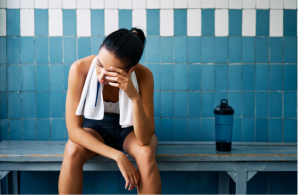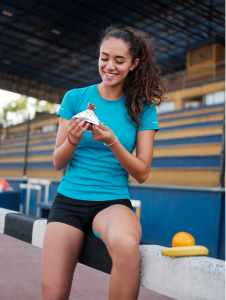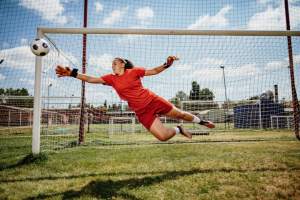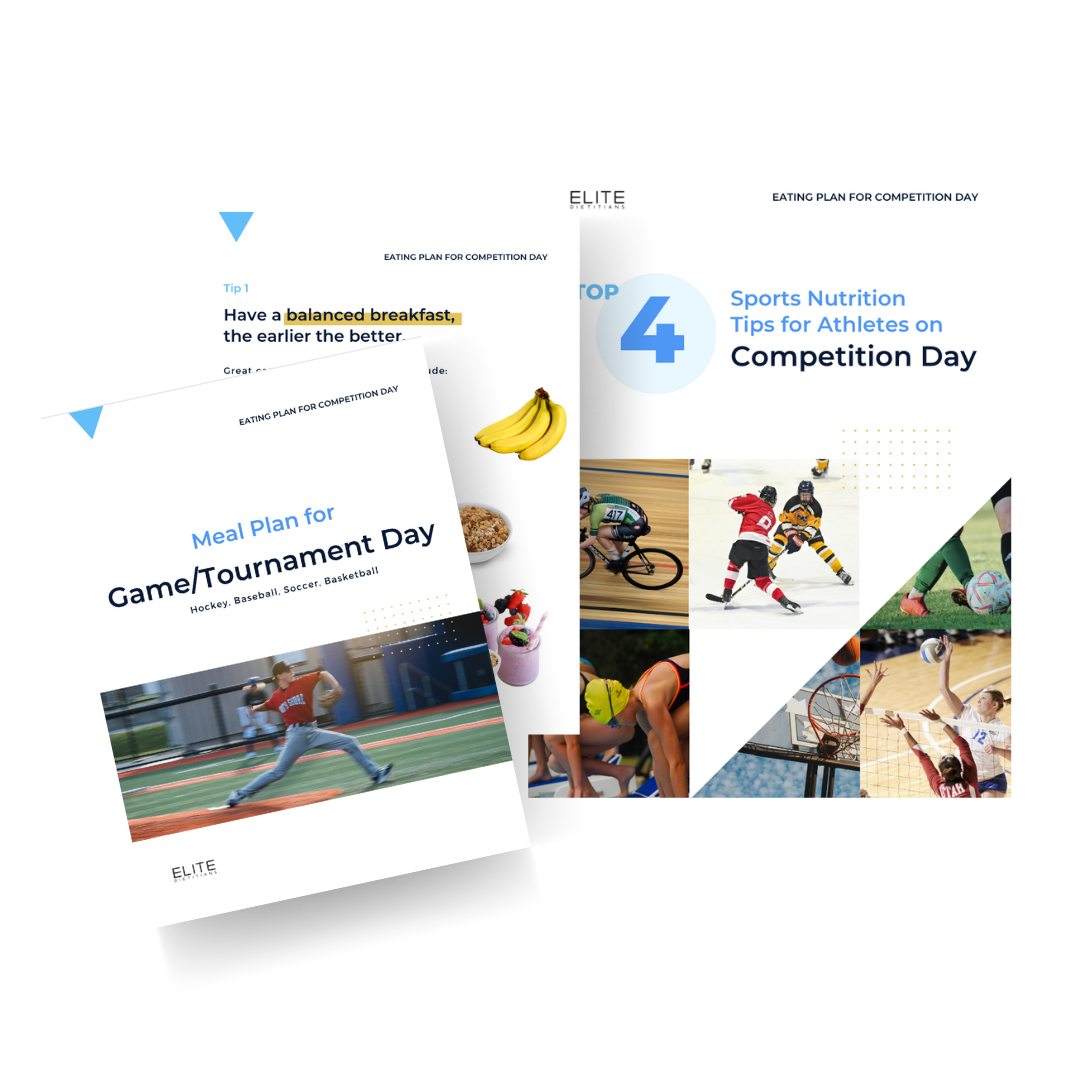All young athletes should know about RED-S, as they are at particularly high risk of this serious condition. Do you know how to prevent Low Energy Availability, and would you recognize the signs of Relative Energy Deficiency in Sport (RED-S)? You probably follow a diligent routine of cross-training, rolling, and rehab. But what if you’re at risk of developing something more serious than an injury? RED-S is a syndrome of poor health and declining athletic performance in athletes who don’t eat enough for their training.
What is RED-S?
RED-S is a syndrome with widespread impact on the athlete’s physical and mental health.
RED-S was formerly known as Female Athlete Triad, a syndrome in female athletes with:
- menstrual loss
- bone loss
- inadequate eating
In actuality, the Female Athlete Triad is a small part of RED-S. It is now called RED-S because it affects both genders and it has complex and far reaching effects on the body.
RED-S affects the athlete’s:
- Bone health
- Menstrual and hormone function
- Metabolic rate
- Digestion
- Immunity
- Muscle building
- Cardiovascular health
- Psychological changes
RED-S has subtle symptoms including:
- Bloating
- Constipation
- Indigestion
- Fatigue, slow heart rate
- Dizziness, low blood pressure
- Sleep problems
- Bone loss
- Anemia
- Depression
- Anxiety
3 Telltale Signs of RED-S:
- Low hormone levels
- Higher injuries and illness
- Declining performance

Many of these symptoms are subtle and seem unrelated so athletes often do not realize that the syndrome has taken hold. Athletes often struggle with RED-S for a long time before seeing a doctor. Athletes will often train through symptoms, discomforts and injuries until the psychological effects of RED-S close in on them. At this point, the athlete develops preoccupations with food and weight and their mood is low or anxious. Just as we need to rest and rehab an injury, athletes need to treat RED-S diligently, in order to overcome this chronic disease. As with other chronic diseases, RED-S does not improve or resolve until it is treated.
How do Athletes Get RED-S?
Athletes develop RED-S when they are training at very high volumes and they are not eating enough to match their training load. Under-fueling can happen accidentally by skipping breakfast, missing recovery snacks or not packing enough food. Under-fueling can also occur when an athlete has delayed meal timing, even if they eat enough later in the day. Not properly fueling up before exercise is enough to cause energy deficiency.
Some of the situations that result in RED-S happen quite by accident and others are the result of dieting while training.
Here are some common examples of how athletes develop RED-S:
- Higher training volume and don’t eat enough food to match it: for example if athlete meals are not organized at a training camp and athletes are not well prepared to supply their own food.
- Fasted workouts and delayed recovery, even if you eat enough later in the day: for example if you regularly skip breakfast before morning training and don’t eat anything until lunch.
- Restrictive diet while training: for example if an athlete is restricting calories or carbohydrates to lose weight during the competitive season.
- Excessive high training volume: for example if an athlete trains on two different teams so they go from one practice to another without eating properly in between.
Which Athletes are at Risk of RED-S?
RED-S happens to athletes of all ages, genders and weight ranges and can occur at any point in an athlete’s career. A 2020 review of RED-S studies reported as many as 58% female and 24% male junior soccer players had Low Energy Availability and the vast majority of the cases were in youth under 16 years old.
Female athletes, elite athletes and young athletes are at particularly high risk of developing the condition.
A study in Clinical Nutrition in 2022 assessed 150 female and male Slovenian competitive athletes using the RED-S CAT tool.
Among 150 elite Slovenian athletes:
- 64% of athletes were at moderate risk of RED-S
- 7% of athletes were at high risk of RED-S and had severe health and performance problems
- young athletes are at higher risk of RED-S, compared to athletes over the age of 21
These findings were repeated with Australian elite female athletes aged 15-32 years, in a 2021 study published in the BJSM. This study used multiple questionnaires including LEAF-Q and they measured RMR, body composition, bone mineral density and blood samples.
Female Australian athletes had even higher rates of REDS:
- 80% female athletes had 1 or more symptoms of RED-S
- 37% athletes had 1-3 symptoms of RED-S
- 1 participant had 5 symptoms of RED-S
Sports prone to RED-S include:
- Track & field
- Endurance sports like running, cycling, cross country skiing
- Intermittent sports like soccer
- Weight sensitive sports like rowing, combat sports, jockeys
- Aesthetic sports like dance, figure skating
Eating habits that raise risk of RED-S include:

- Restrictive Eating Behaviours such as:
- Disordered eating, counting calories
- avoiding food groups, strict diet
- rigid food rules or preoccupation with “healthy food”
- Within Day Energy Deficiency:
- Training fasted or under fueled, even if you eat enough later in the day
- Forgetful Eating:
- Low hunger or drive to eat, “no time” to eat
- Forget to eat even when hungry
- Miss breakfast, and recovery snack after a workout
- Not packing enough food for a long training day
- High Volume training:
- Extra workouts or skipping rest days
Prevent RED-S in Young Athletes
There’s a lot we can do as an athlete community to keep our athletes healthy and strong and to prevent RED-S. All athletes benefit from meeting with a sport dietitian to build a nutrition plan that properly fuels their sport. A nutrition plan needs to be adjusted during different phases of training and periods of high training volume.
For more information on how to fuel your sport, check out these sport nutrition courses that cover all you need to know to fuel a young athlete for training and competitions
Nutrition Plan to Protect Against RED-S:
- Have 3 meals and 3 snacks a day
- Set a timer to eat every 3 hours
- Eat 1 hour before training
- Eat immediately after training
- Have a snack during long workouts or games
- Pack enough food for training and competition days

Team Strategies to Keep our Athletes Safely out of RED-S:
- Provide education so that coaches, families and all young athletes know about RED-S
- Support athletes to organize their meals and snacks during training camps and high-volume training.
- Encourage all athletes to eat before every practice.
- Allow athletes time to have a snack during long workouts or tournaments.
- Remind athletes to eat a recovery snack right after every practice.
- Promote an “all foods fit approach” for athletes.
- Ensure that athletes who are minors have an adult or team manager who is responsible to oversee athlete food and nutrition needs during travel.
- Create guidelines and resources to support athlete nutrition needs during travel.
Screen Athletes for RED-S
All athletes should know about RED-S and their parents and coaches should screen for RED-S. Increasing awareness of the risk factors and signs of RED-S, is important for early detection and treatment. An athlete should see a doctor if they are feeling regularly fatigued, have digestive complaints, psychological changes, sleep problems or seem to get sick or injured frequently with a delayed recovery. Seeking treatment quickly will speed up recovery and get the athlete back to high performance.
Treatment and Recovery from RED-S
Are the Effects of RED-S Reversible?
Thankfully, the psychological and metabolic effects of RED-S are reversible, with the exception of any bone loss that may have occurred. Once hormone levels recover and menstruation is regular, the athlete has achieved a successful recovery. The preoccupations and psychological impacts of RED-S typically disappear when the athlete has recovered from RED-S.
Where to go for Help with RED-S Treatment:
If you or your athlete may have RED-S, it is important to meet with your doctor and ask for a referral to a sport medicine physician and sport dietitian who are familiar with RED-S. RED-S treatment requires clinical intervention with a multidisciplinary team, including a sports medicine physician, sports dietitian, and psychologist.
The 4 Key Strategies for RED-S Recovery:
- A Nutrition Plan: A nutrition plan designed by a sports dietitian gives the athlete enough fuel for their training level.
- Safe Training: Most athletes can continue to train during recovery from RED-S, sometimes the team makes minor adjustments to their training volume until they are able to follow their nutrition plan.
- Consistent Sleep Routine: A consistent sleep routine, so going to bed and waking up at the same time and getting enough sleep is key to recovery as it stabilizes hormone levels.
- Weight Restoration: If an athlete has lost weight, then restoring their previous healthy weight is essential for treatment.
What if there is an eating disorder or weight preoccupations?
When an athlete has been living with RED-S for some time, it can be hard for them to adjust their eating habits especially if they have acquired disordered eating behaviours or preoccupations. In these cases treatment can be more challenging, but with the close support of a psychologist and sports dietitian, the athlete can change their eating habits in incremental steps.
Will I Have to Stop Training?
Probably not. Most athletes are able to continue at their same training level through treatment, as long as they can follow the nutrition plan. Sometimes the training volume makes it challenging to eat enough and overcome Low Energy Availability. The team can adjust training volume until the athlete is in energy balance. We need to prioritize the health of the athlete over short-term training goals and support them to follow their recovery plan.
Take the RED-S Course: Protect Yourself and Your Team
The key to prevention is education for athletes, parents, IST members and coaches. All young athletes should know about RED-S, the signs and symptoms, how to prevent it and where to go for treatment.
Take this course RED-S: What Every Athlete Needs to Know for hands-on practical tools, tips and strategies to screen and guide RED-S prevention and recovery.
This course was developed for athletes and their support teams by Cristina Sutter, sport dietitian and Dr Sara Forsyth, a Vancouver based sports medicine physician who specializes in the treatment of athletes with RED-S.
View RED-S Course









3 Comments